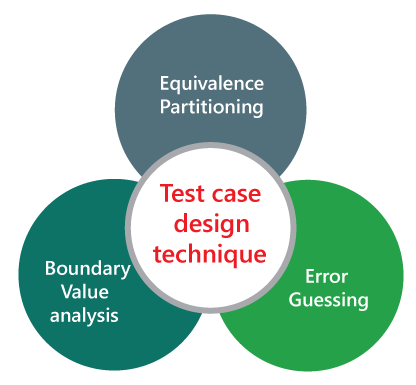Error Guessing TechniqueThe test case design technique or methods or approaches that need to be followed by every test engineer while writing the test cases to achieve the maximum test coverage. If we follow the test case design technique, then it became process-oriented rather than person-oriented. The test case design technique ensures that all the possible values that are both positive and negative are required for the testing purposes. In software testing, we have three different test case design techniques which are as follows:

In this section, we will understand the first test case design technique that is Error guessing techniques. Error guessing is a technique in which there is no specific method for identifying the error. It is based on the experience of the test analyst, where the tester uses the experience to guess the problematic areas of the software. It is a type of black box testing technique which does not have any defined structure to find the error. In this approach, every test engineer will derive the values or inputs based on their understanding or assumption of the requirements, and we do not follow any kind of rules to perform error guessing technique. The accomplishment of the error guessing technique is dependent on the ability and product knowledge of the tester because a good test engineer knows where the bugs are most likely to be, which helps to save lots of time. How does the error guessing technique be implemented?The implementation of this technique depends on the experience of the tester or analyst having prior experience with similar applications. It requires only well-experienced testers with quick error guessing technique. This technique is used to find errors that may not be easily captured by formal black box testing techniques, and that is the reason, it is done after all formal techniques. The scope of the error guessing technique entirely depends on the tester and type of experience in the previous testing involvements because it does not follow any method and guidelines. Test cases are prepared by the analyst to identify conditions. The conditions are prepared by identifying most error probable areas and then test cases are designed for them. The main purpose of this technique is to identify common errors at any level of testing by exercising the following tasks:
The increment of test cases depends upon the ability and experience of the tester. Purpose of Error guessingThe main purpose of the error guessing technique is to deal with all possible errors which cannot be identified as informal testing.
Depending on the tester's intuition and experience, all the defects cannot be corrected. There are some factors that can be used by the examiner while using their experience -
Examples of Error guessing methodExample1A function of the application requires a mobile number which must be of 10 characters. Now, below are the techniques that can be applied to guess error in the mobile number field:
After implementing these techniques, if the output is similar to the expected result, the function is considered to be bug-free, but if the output is not similar to the expected result, so it is sent to the development team to fix the defects. However, error guessing is the key technique among all testing techniques as it depends on the experience of a tester, but it does not give surety of highest quality benchmark. It does not provide full coverage to the software. This technique can yield a better result if combined with other techniques of testing. Example2Suppose we have one bank account, and we have to deposit some money over there, but the amount will be accepted on a particular range of which is 5000-7000. So here, we will provide the different input's value until it covers the maximum test coverage based on the error guessing technique, and see whether it is accepted or give the error message:
Note: Condition: if amount >5000 and amount<7000 amount And, if we enter 5000 → error message (not accepted based on the condition) 7000→ error message (not accepted based on the condition) Advantages and disadvantage of Error guessing techniqueAdvantagesThe benefits of error guessing technique are as follows:
DisadvantageFollowing are the drawbacks of error guessing technique:
Next TopicEquivalence Portioning Technique
|
 For Videos Join Our Youtube Channel: Join Now
For Videos Join Our Youtube Channel: Join Now
Feedback
- Send your Feedback to [email protected]
Help Others, Please Share










